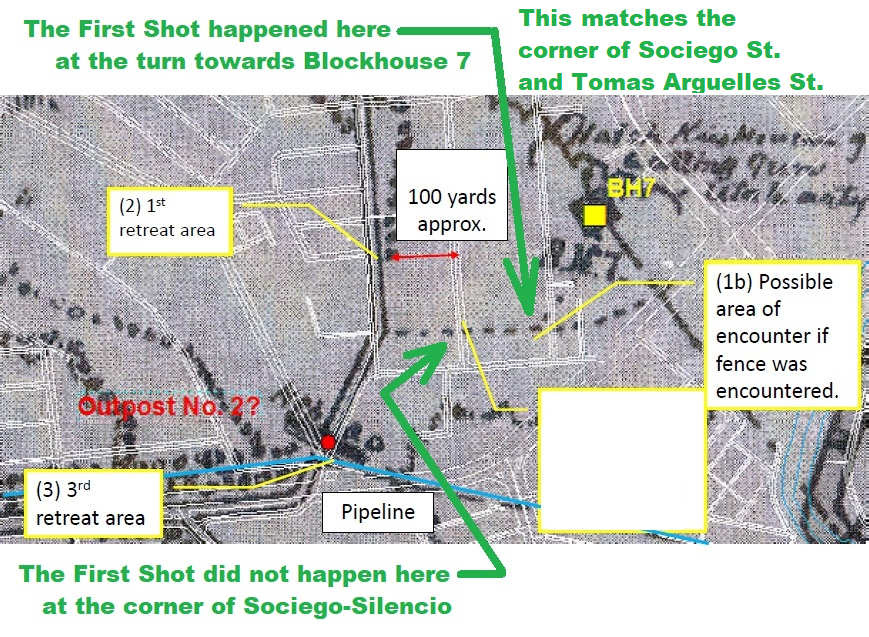
Original image from: Geospatial Analysis of the First Shot of the Philippine-American War
Ariel C. Blanco, Rene R. Escalante, Emmanuel N. Encarnacion
Historical Background:
From 1899 and for more than a century, the accepted story was that the first shot of the Phil-Am War happened on San Juan Bridge itself. This stemmed from the fact that the 1st Nebraska Regiment was sent in that area to guard the bridge, so any incident that happened there would be described as "at the bridge." The "at" here meant in and around. However, this description is ambiguous. It can, and it did, take the form that the first shot happened on the bridge itself, which is erroneous if we consider Lt. Whedon's and Pvt. Grayson's accounts.
In 2003, in recognition of the accounts of Lt. Whedon and Pvt. Grayson, the First Shot Marker was moved from San Juan Bridge to corner Sociego-Silencio. This was to address the fact that the First Shot Incident did not happen on San Juan Bridge itself.
However, correcting one mistake only led to another mistake. That's because the reasoning behind Sociego-Silencio was faulty as well. The only argument for Sociego-Silencio was that it lies one hundred yards from Santol, 100 yards being the farthest that Lieut. Whedon had ordered his men to patrol. But the Legarda Study failed to use Lt. Whedon's estimate of what a 100 yard distance is, despite claiming that it used "Lt. Whedon's calculation of 100 yards." Lt. Whedon never said that from Santol to Sociego-Silencio is 100 yards. What Lt. Whedon said was that from Outpost 2 to Santol is 100 yards, and on the old military map and current satellite map, this is the same distance from Santol to Sociego-Arguelles. Had the Legarda Study used Lt. Whedon's estimate of what a 100 yard distance is, it would arrive at Sociego-Arguelles (not Sociego-Silencio.)
In 2014, a Geospatial Study of the First Shot incident indicated that because there's a fence in Pvt. Grayson's reenactment photos, the "turn towards Blockhouse 7," which matches corner Sociego-Arguelles, is a possible spot.
This Ronnie Miravite Casalmir Study takes that further.
For in the background of Pvt. Grayson's reenactment photo appears the smoking gun, hidden in plain sight, the image of Blockhouse 7.
By comparing the profile of this image with the profile of Blockhouse 7 in a known photo, we can triangulate where exactly did the First Shot incident happen, and that's at the "turn towards Blockhouse 7" or what is now the corner of Sociego-Arguelles.
|
BLOCKHOUSE 7 IS IN THE BACKGROUND OF GRAYSON'S REENACTMENT PHOTO THIS IS THE SMOKING GUN !!! |
First, let's look at Grayson's reenactment photo. Apparently, unbeknownst to everyone, Blockhouse 7 is in the background of the photo. But being attentive to detail that I am, and being familiar with how some of the blockhouses looked like, the structure above Grayson that appears to be the top of a blockhouse jumped out on me. And upon closer inspection, and comparing with a known photo of Blockhouse 7, it was indeed confirmed to be Blockhouse 7.
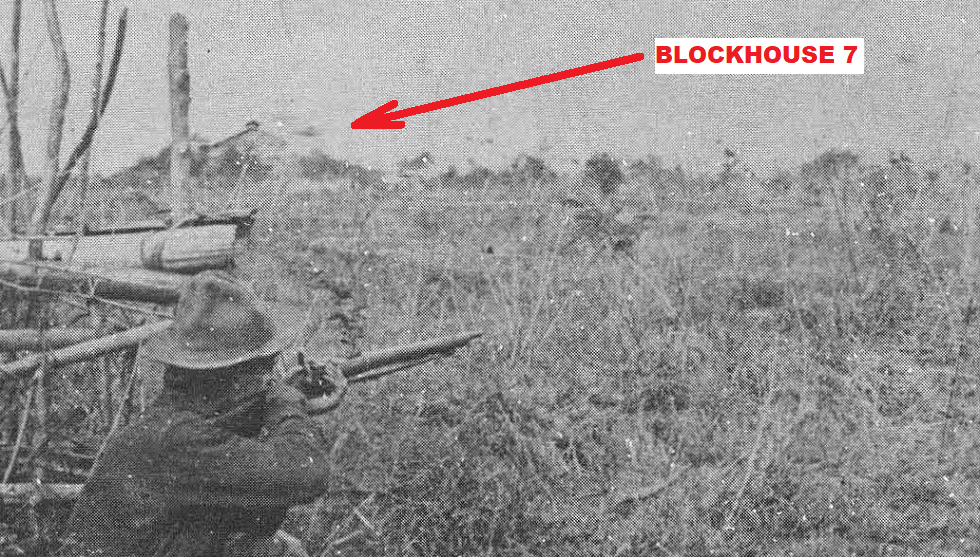

did caption the same photo (below, left) as being "at block house on the hill"
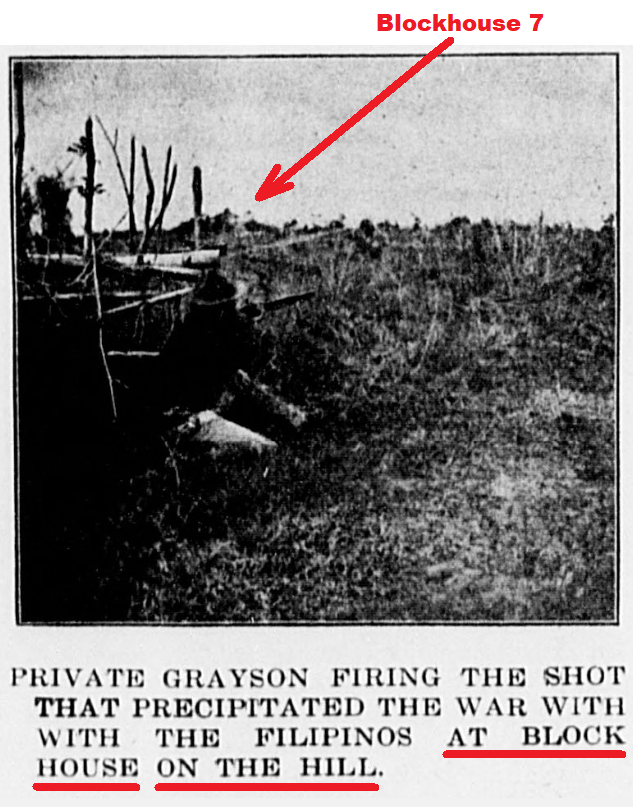
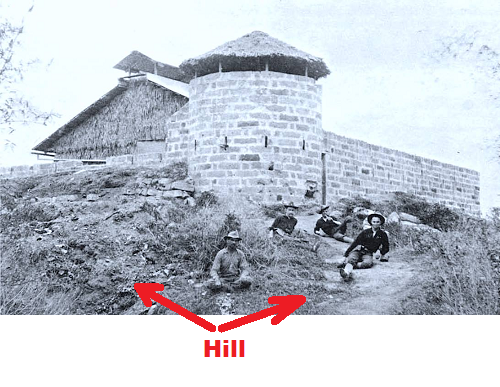
|
GRAYSON'S REENACTMENT PHOTO AND THE KNOWN PHOTO OF BLOCKHOUSE 7 WERE TAKEN FROM ALMOST THE SAME DIRECTION |
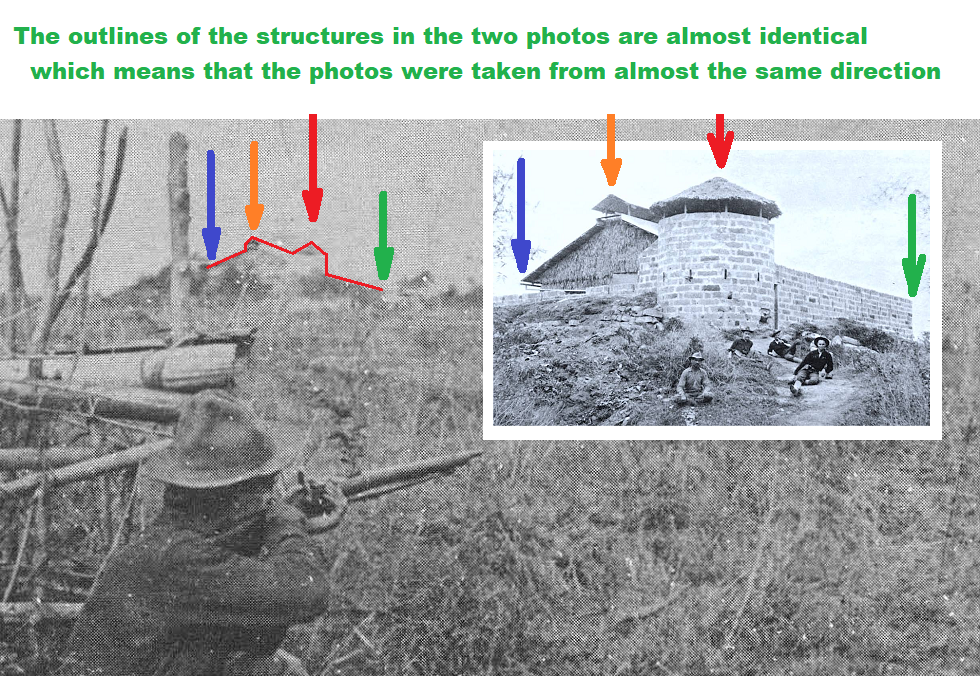
|
THE KNOWN PHOTO OF BLOCKHOUSE 7 WAS TAKEN FROM THE DIRECTION OF THE TRAIL |
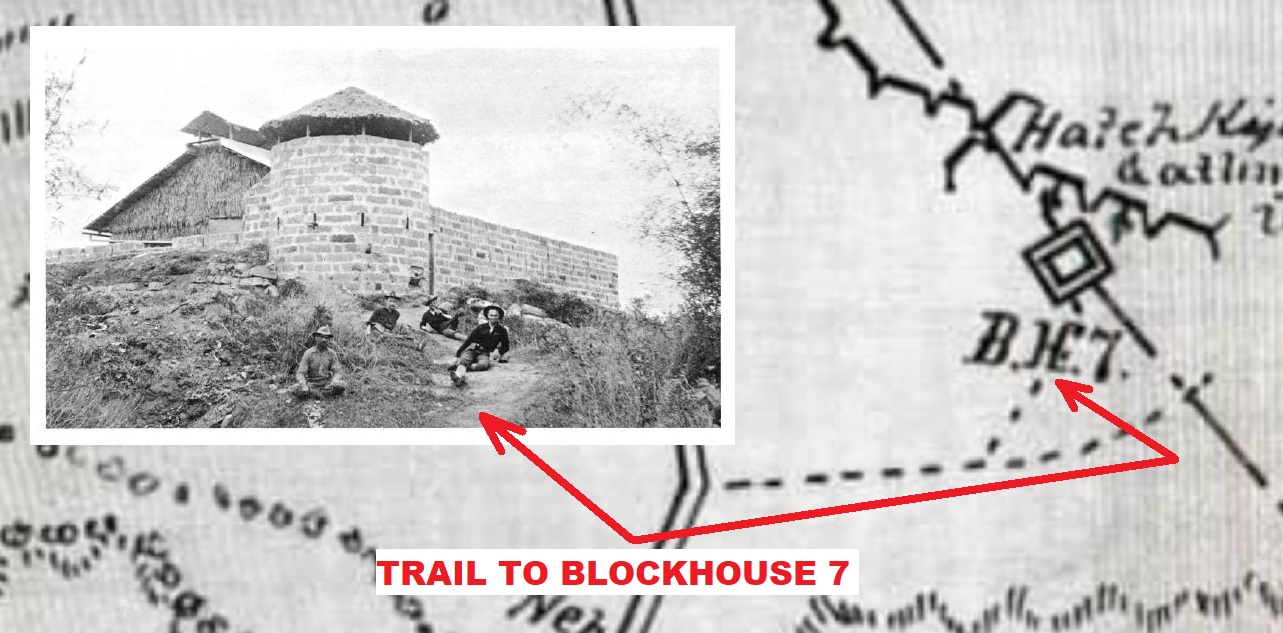
|
THEREFORE, GRAYSON'S PHOTO WAS TAKEN NEAR THE START OF THE TRAIL OR NEAR THE "TURN" TOWARDS BLOCKHOUSE 7 |
|
Since the two photos were taken from almost the same direction, and the known photo of Blockhouse 7 was taken from the direction of the trail, then Grayson's photo was taken near the start of the trail to Blockhouse 7, or near the turn to Blockhouse 7 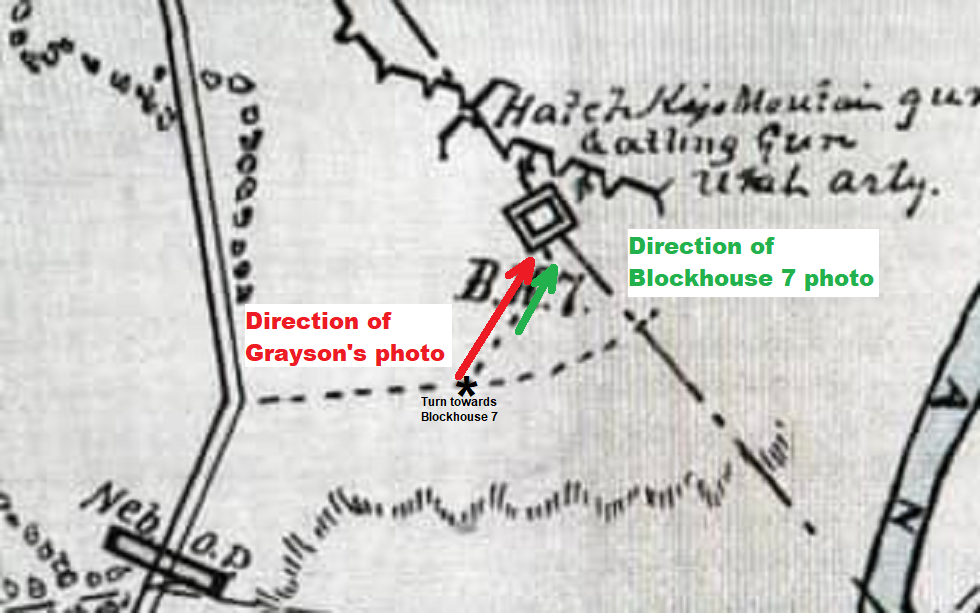 |
The profile of Blockhouse 7 in Grayson's reenactment photo would appear differently if the reenactment photo was taken at Sociego-Silencio.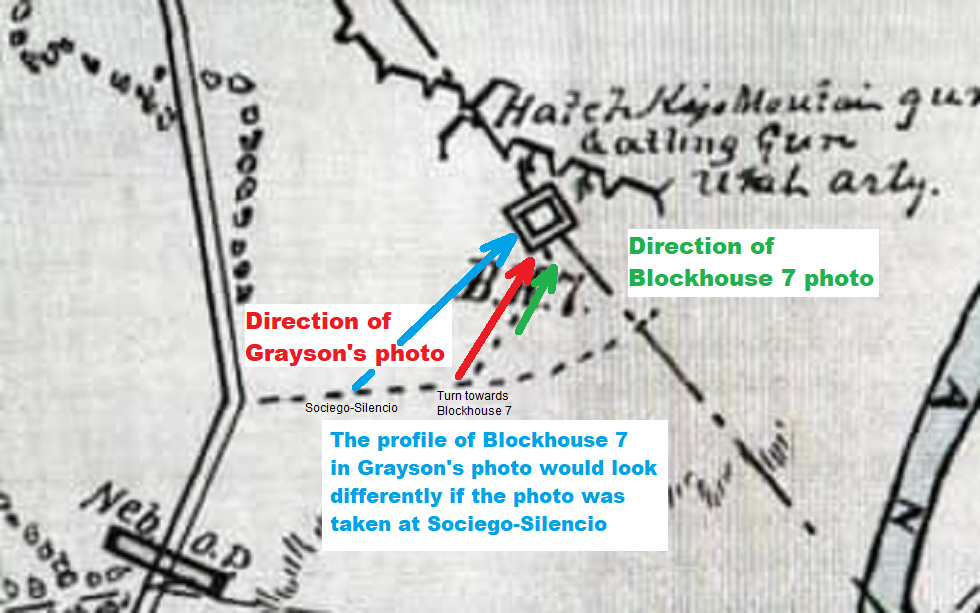 |
| THE ROUND TOWER |
The "round tower" corner is pointing towards the "turn" and the cameraman in both photos. This is consistent with Grayson's photo being taken near the "turn" towards Blockhouse 7.
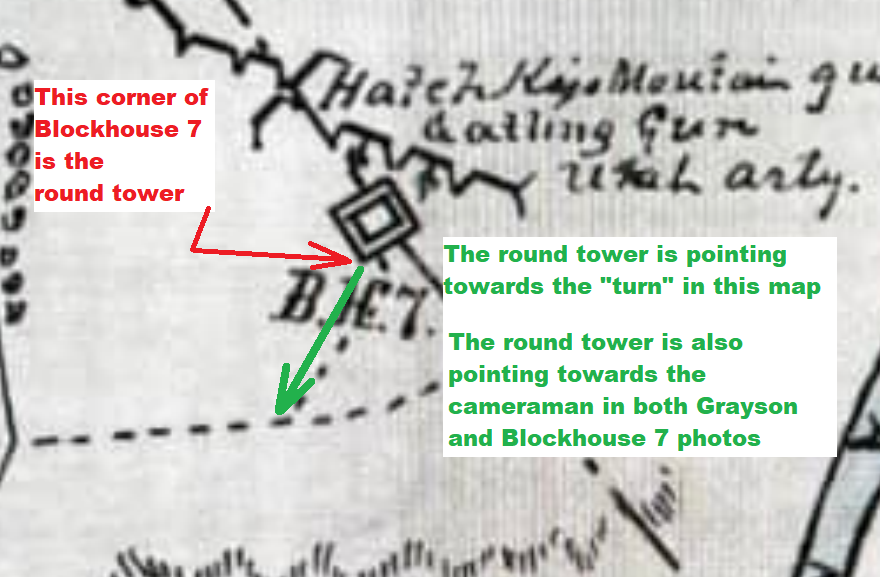
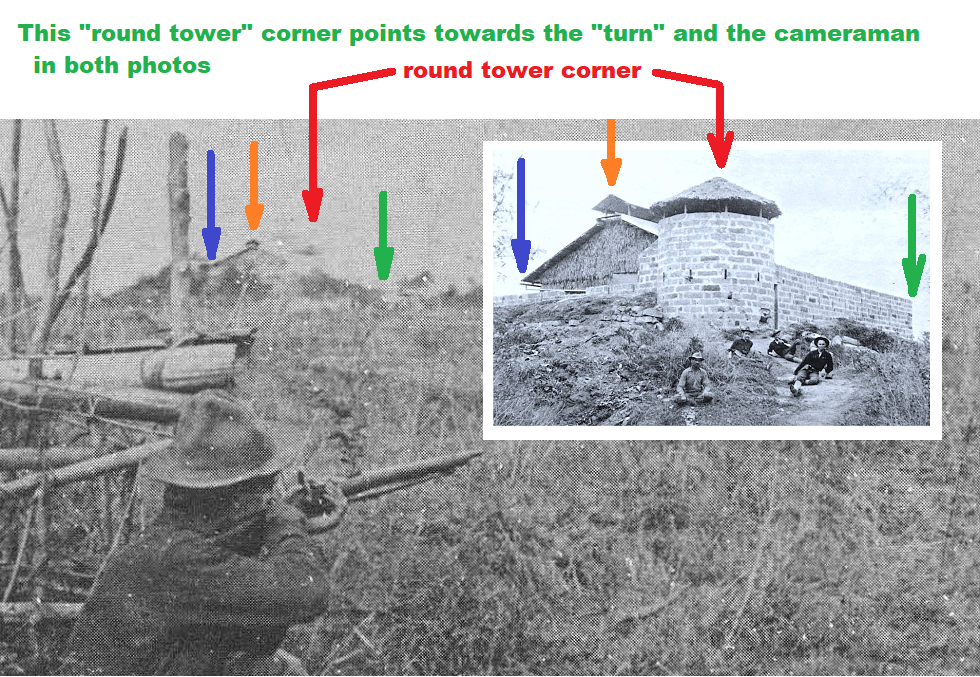
| THE WALL |
Had Grayson's photo been taken from Sociego-Silencio, the wall in Grayson's photo would be angled more inward and the length would appear shorter compared to the wall in the known Blockhouse 7 photo which was taken from the direction of the trail, but the two have exactly the same angles and are comparatively similar in length.
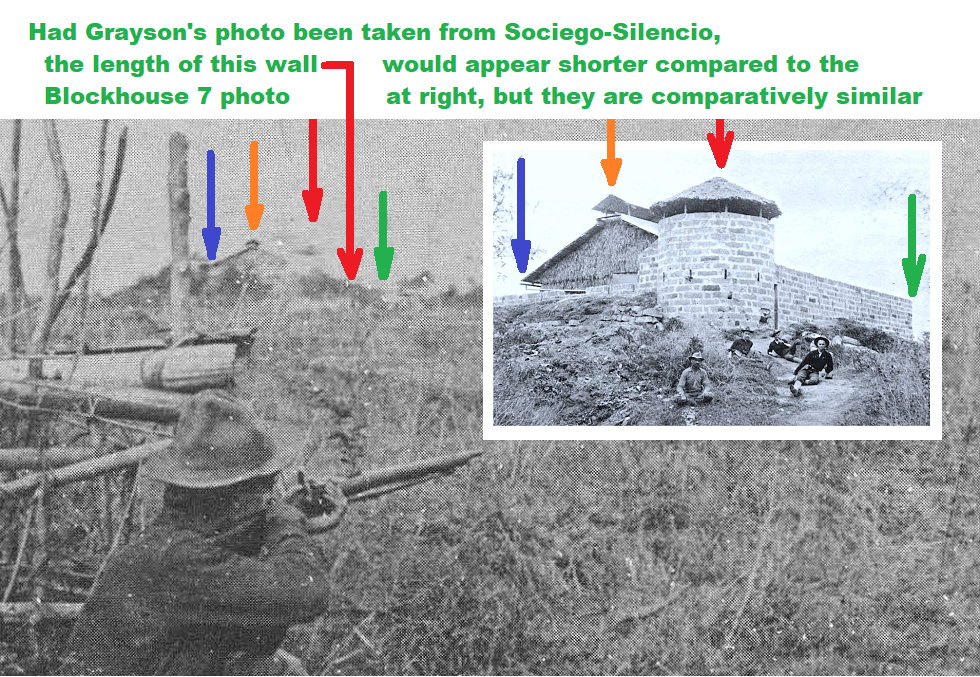
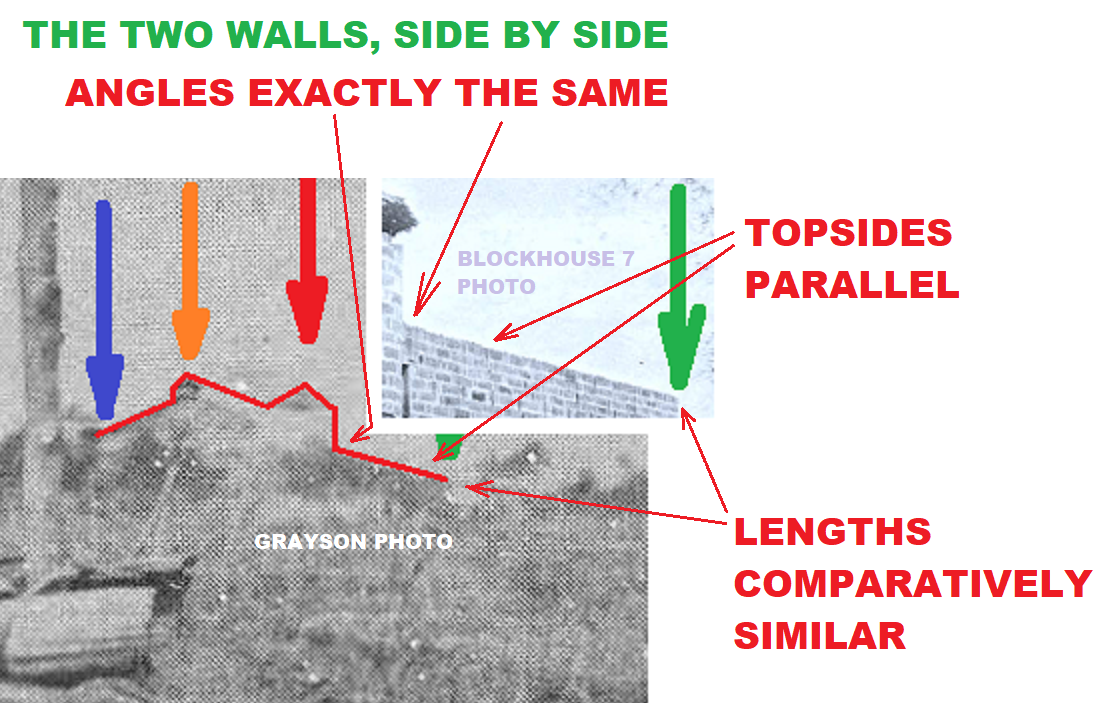
| THE ROOF |
If we compare the outline of the structures in Grayson's photo and the known photo of Blockhouse 7, there's a slight variation in the length of the roof. That's because as the cameraman goes closer to the Blockhouse, he goes to the right of the round tower, and the round tower in front moves to the left covering more of the roof.
This is consistent with Grayson being near the "turn."
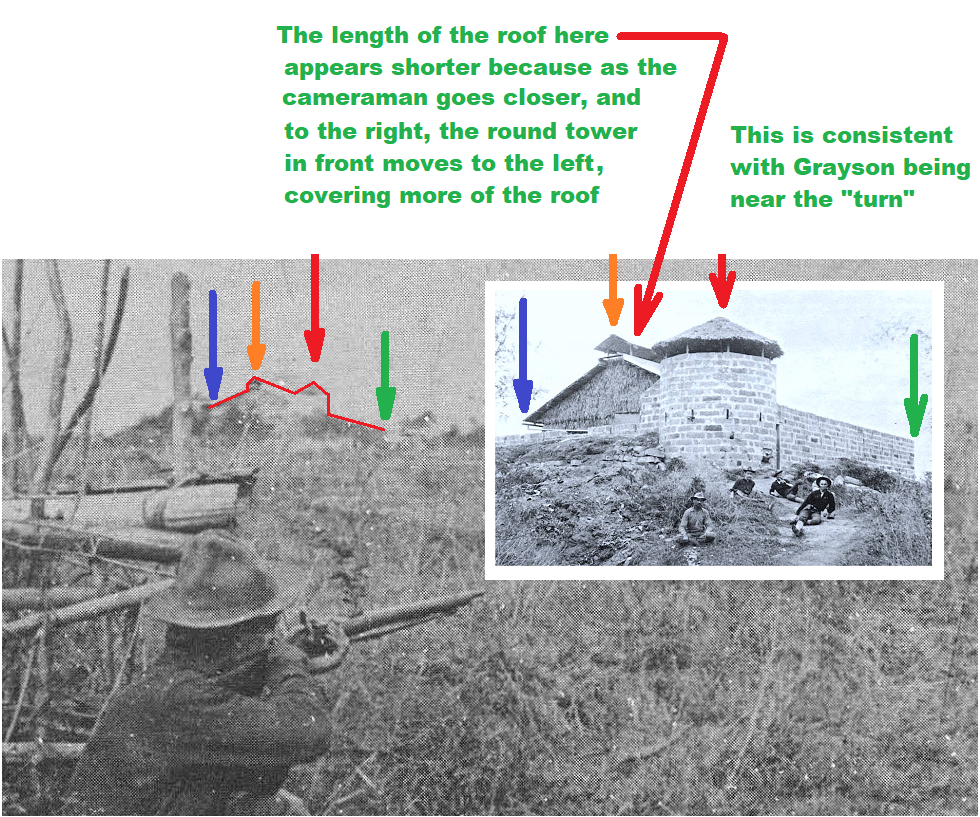
| LIEUT. WHEDON'S 100 YARDS |
The only argument for Sociego-Silencio is that it lies one hundred yards from Santol, 100 yards being the farthest that Lieut. Whedon had ordered his men to patrol.
But the Legarda Paper and the Geospatial Analysis erred in injecting their own measurements when they should have adopted Whedon's measurement instead, despite the Legarda Paper's claim of using "Whedon's calculation of 100 yards."
Since it was Lieut. Whedon who said that he ordered his men to patrol 100 yards, it should be Lieut. Whedon's estimate of what a 100 yard distance is that should be considered, not my estimate, not the Geospatial Analysis' estimate, not Dr. Legarda's estimate, not even the actual distance.
And Lt. Whedon never said that from Santol to Sociego-Silencio is 100 yards.
Instead, according to Lieut. Whedon, from Outpost 2 to Santol is 100 yards. On the old military map and the current satellite map, this is the same distance from Santol to the "turn to Blockhouse 7" or corner Sociego-Arguelles. Which means that when Lieut. Whedon ordered his men to patrol 100 yards, he meant them to patrol all the way to Sociego-Arguelles, and not just up to Sociego-Silencio.
The Geospatial Analysis, to their credit, did entertain the idea that Grayson and Miller could have patrolled all the way to the "turn to Blockhouse 7" or corner Sociego-Arguelles, beyond the Geospatial Analysis' 100-yard distance.
According to Lieut. Whedon, from Outpost 2 to Santol is 100 yards.
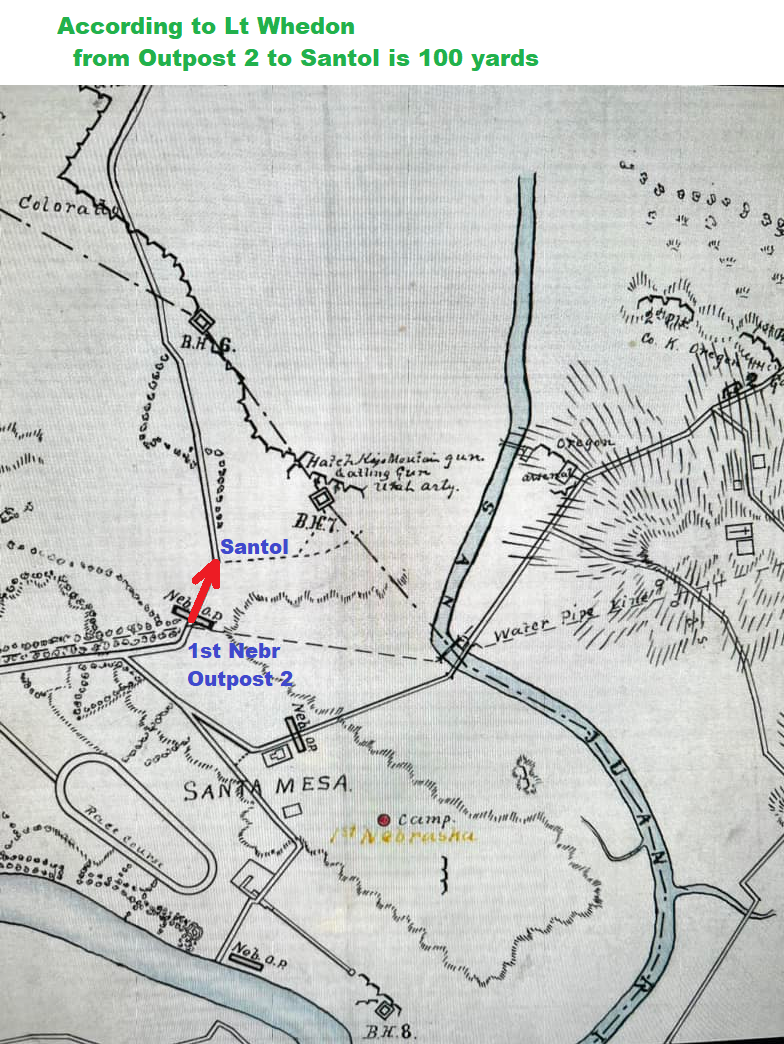
If we look at the map, the distance between Outpost 2 and Santol, and the distance between Santol and the fork, are the same, which means that, per Lt. Whedon's estimate, from Santol to the "turn towards blockhouse 7" is also 100 yards.
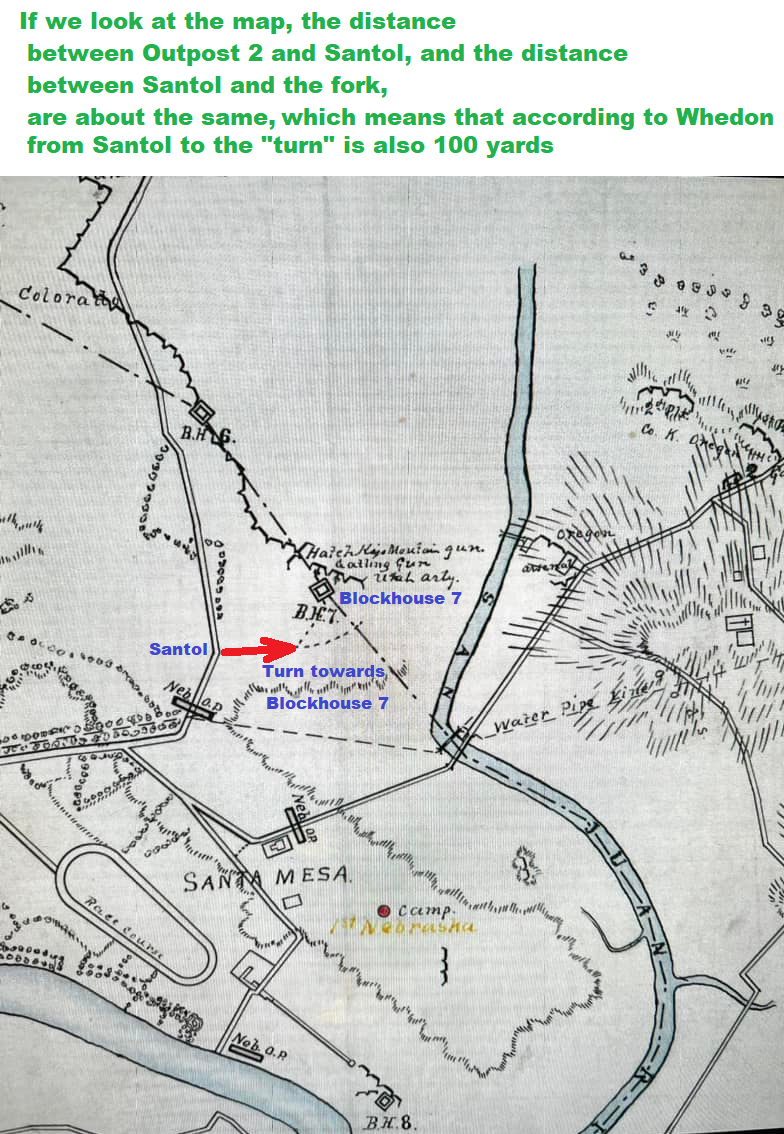
Such that, when Lt. Whedon ordered his men to patrol 100 yards, he meant them to patrol up to the "turn" to Blockhouse 7, and not just up to Sociego-Silencio.
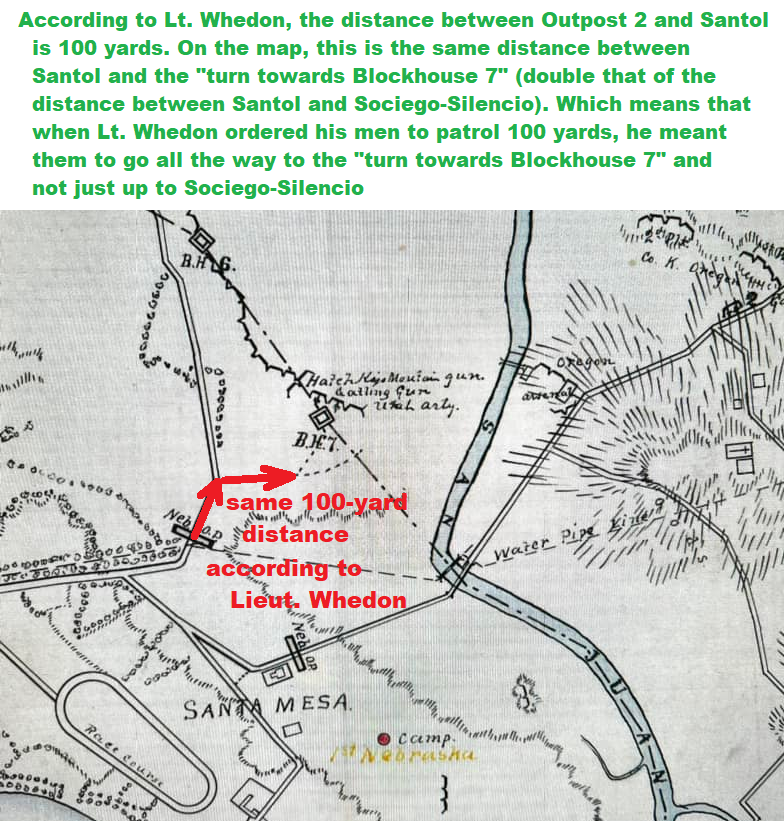
The current satellite map corroborates that the distance between Outpost 2 and Santol is the same as the distance between Santol and Sociego-Arguelles, and the former is said to be 100 yards by Lt. Whedon.

In comparing the current satellite map and the old military map, we have to take note that the Old Sociego Trail was above the Current Sociego Street ... On the current satellite map, if we move Sociego Street to where the Old Sociego Trail would have been, the distances shown immediately above would fit perfectly.
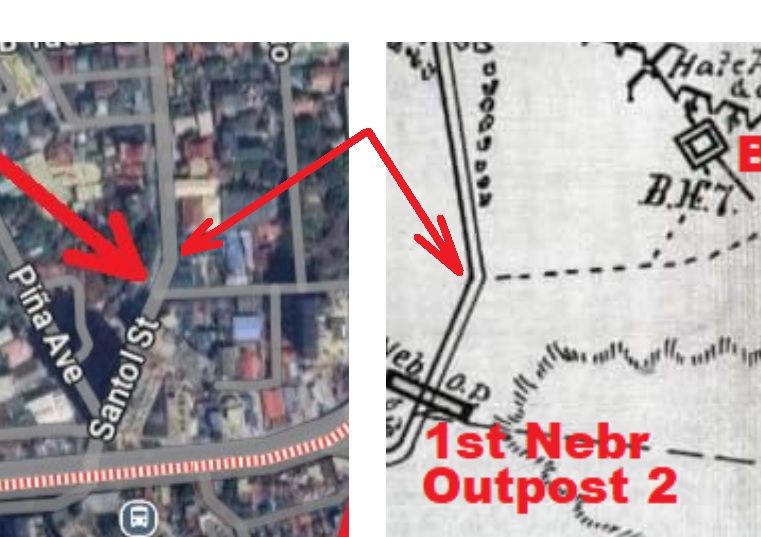
| COL. STOTSENBURG'S 100 YARDS |
According to Col. Stotsenburg, the distance between Santol and Blockhouse 7 was 200 yards.
He said, "At about half past eight p. m. the guard in the village of Santol about 200 yards southwest of Blockhouse No. 7 challenged four armed Philippinos and ordered them to halt."
This would put the distance between Santol and the "Turn to Blockhouse 7" (corner Sociego-Arguelles) at 100 yards, same as Lieut. Whedon's.
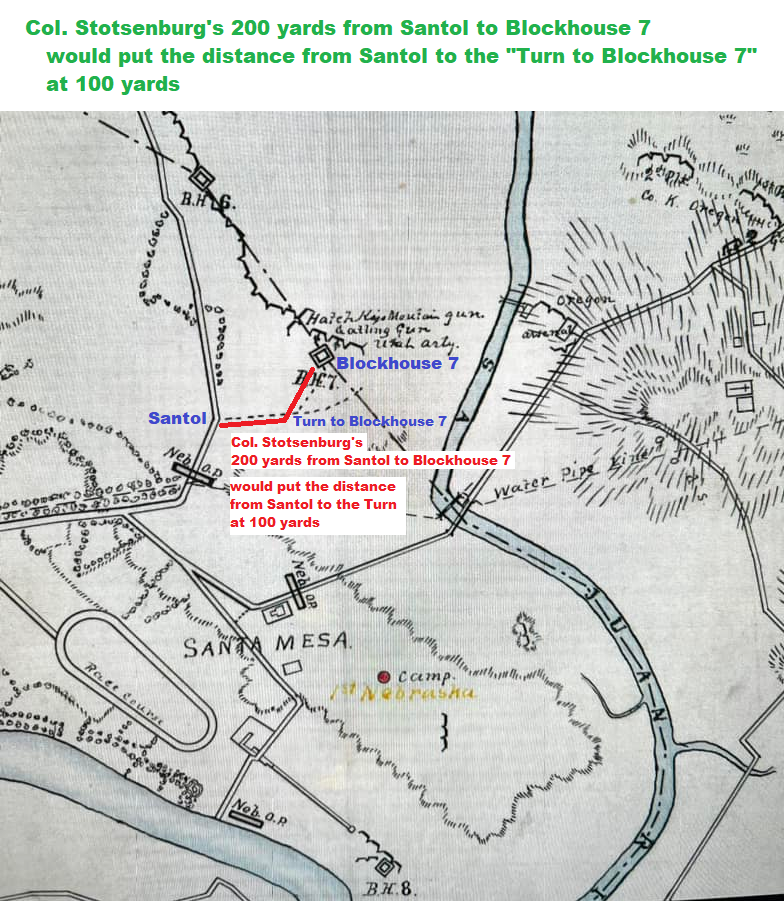
| GRAYSON'S 100 YARDS |
Grayson's 100 yards estimate would put the "turn" very much well inside the 100 yard distance.
According to Grayson, the distance between Outpost 2 and Blockhouse 7 is 100 yards.
He said: "At 8 o'clock on the morning of February 4, I went on duty at outpost 2, which was about 100 yards from block house 7."
The distance between Outpost 2 and Blockhouse 7 is longer than the distance between Santol and the "turn," thereby making the latter distance well within Grayson's 100 yards, and within the possible areas of encounter.
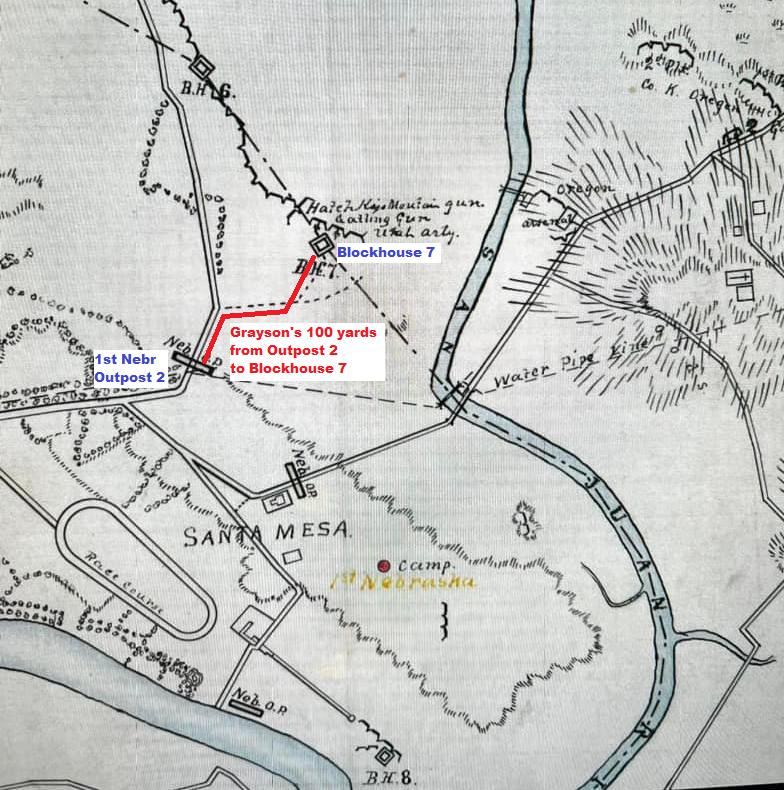
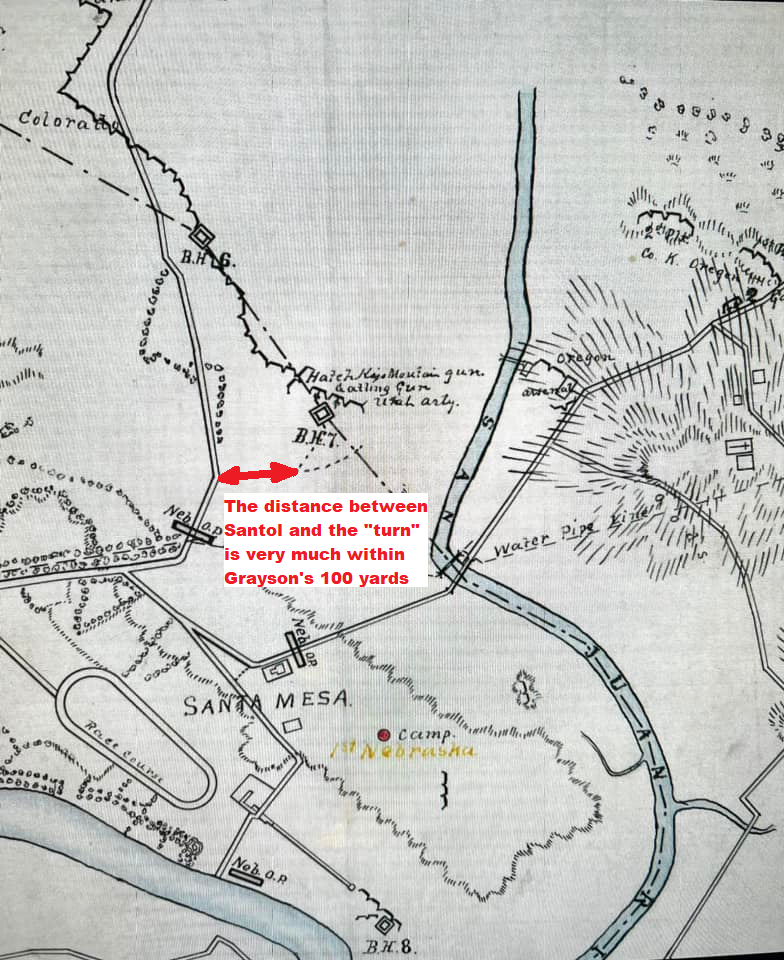
| THE WAITING FOR INSURGENTS |
Lt. Whedon said that three of his men advanced from Santol and waited to see if there were any insurgents in the vicinity.
Why wait?
And where to wait?
Take note that Lt. Whedon ordered them to patrol those 100 yards every half hour.
This meant that they were there to make sure that those 100 yards were cleared of Filipinos.
To comply with Whedon's order to clear the area of Filipinos, they would have to be at the end of that 100 yard distance and wait for the Filipinos to approach and enter the 100 yard zone.
This would put them exactly at the turn to Blockhouse 7 if we follow Lt. Whedon's measurement of 100 yards.
The "waiting" here meant that they were there waiting for Filipinos to emerge from that turn.
| THE SUDDEN APPEARANCE AT 5 YARDS AWAY |
This would support the previous element of "waiting."
According to Lt. Whedon, Private Grayson saw four armed men suddenly appear five yards in front of him.
Lt. Whedon said, "After waiting about five minutes Private Grayson saw four armed men suddenly appear five yards in advance of him."
Why sudden?
And why 5 yards?
Was it because it was dark (nighttime) and visibility was 5 yards away?
Or was it because the four men had emerged from the turn, and this turn was 5 yards in front?
| GRAYSON HIMSELF HAD PUT IT AT 5 TO 10 YARDS AWAY |
Grayson's own words were "In a moment something rose slowly up, not twenty feet in front of us. It was a Filipino. They were evidently moving dangerously near."
Another newspaper stated that Grayson said "not thirty feet" away.
Did Grayson mean that the Filipino was emerging from the turn from Blockhouse 7?
Grayson continued, "Then two Filipinos sprang out of the gateway about fifteen feet from us."
|
WITH GRAYSON LOCATED ABOUT 7 YARDS OR SO AWAY FROM THE "TURN" THIS WOULD JIBE WITH HIS REENACTMENT PHOTO |
With Grayson about 5 yards, or no more than 20 feet or 30 feet, away from the turn, then this would jibe with the angle of Blockhouse 7 in his reenactment photo.
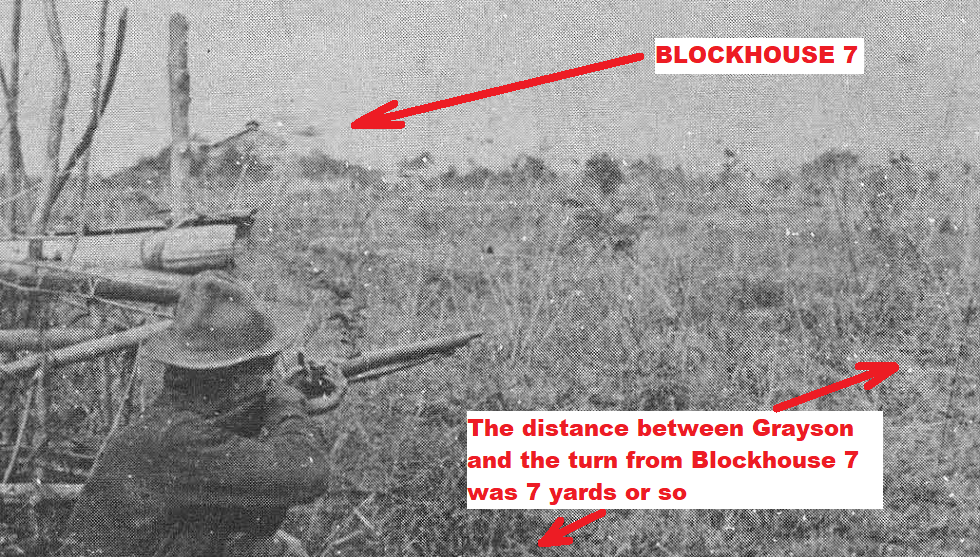
| THE PRESENCE OF A FENCE ALSO POINTS TO THIS SPOT |
According to the Geospatial Analysis, this "turn" towards Blockhouse 7 is a possible area of encounter if a fence was encountered.
We do have a fence in Grayson's photo, right?
In fact, in almost all of Grayson's photos.
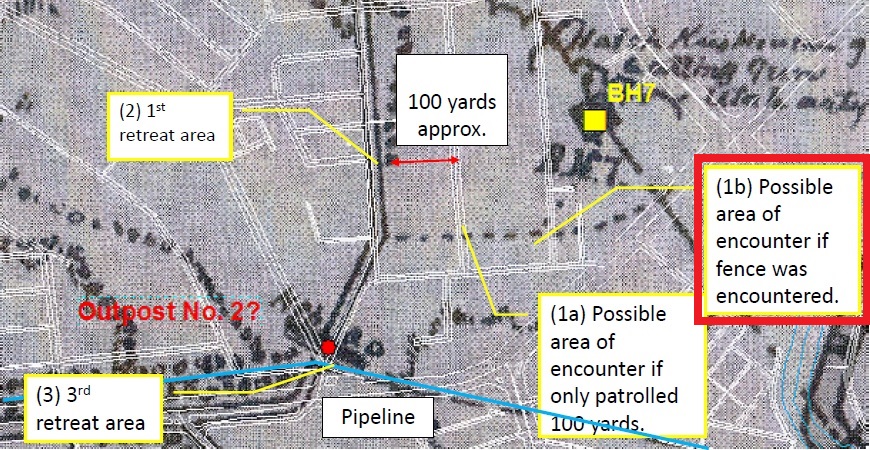
Image from: Geospatial Analysis of the First Shot of the Philippine-American War
Ariel C. Blanco, Rene R. Escalante, Emmanuel N. Encarnacion
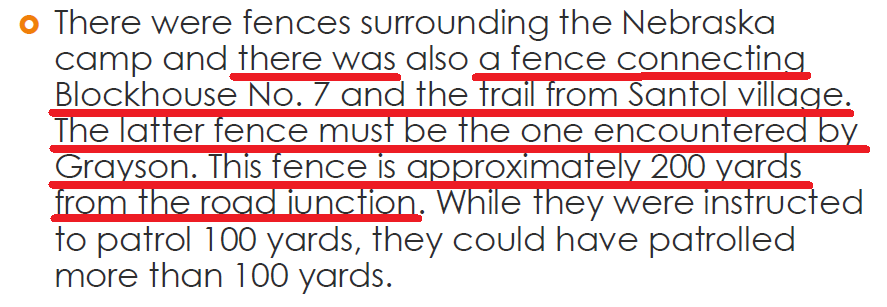
Image from: Geospatial Analysis of the First Shot of the Philippine-American War
Ariel C. Blanco, Rene R. Escalante, Emmanuel N. Encarnacion
|
THERE WAS A FILIPINO OUTPOST ALONG THE TRAIL FROM BLOCKHOUSE 7 JUST BEFORE THE TURN FROM WHERE THE FILIPINOS COULD HAVE COME FROM |
There was a Filipino outpost along the trail from Blockhouse 7, just before the turn.
The presence of this outpost during the encounter itself was mentioned in Grayson's statement: "Suddenly, near at hand on our left, there was a low but unmistakable Filipino outpost signal whistle."
In fact this outpost may be the reason for Grayson's waiting. Grayson and others were waiting for the Filipinos to emerge from this outpost, and the Filipinos did.
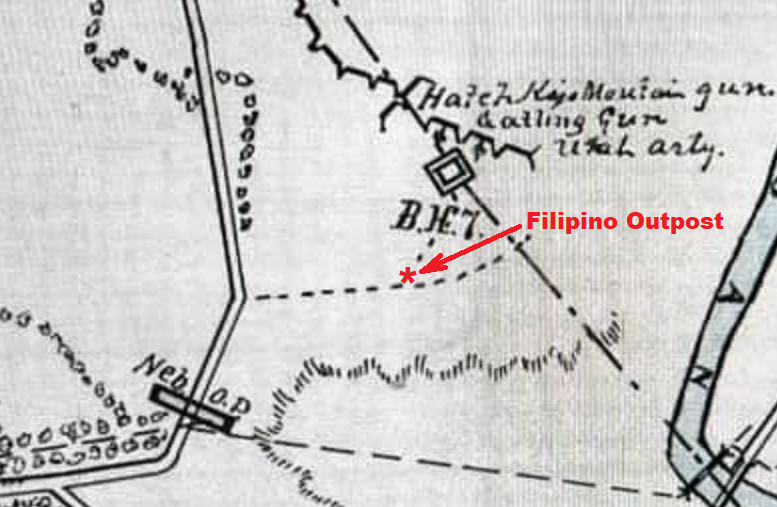
|
THE FILIPINO VERSION PLACED THE FILIPINOS IN FRONT OF BLOCKHOUSE 7 WHICH MAY ACTUALLY BE IN FRONT OF THIS FILIPINO OUTPOST |
In the report of the commander of the Filipino column, he placed the three Filipino soldiers at the door of Blockhouse 7, in other words, in front of Blockhouse 7.
Between the "turn towards Blockhouse 7" and "Sociego-Silencio," the front of Blockhouse 7 would apply more to the "turn towards Blockhouse 7" rather than "Sociego-Silencio."
And since there was this Filipino outpost just before the "turn" that may be considered as an outpost or subpost of Blockhouse 7, the Filipino commander may have well referred to the front of this outpost as the front of Blockhouse 7. If so, then that would put the Filipinos squarely on the turn from Blockhouse 7.
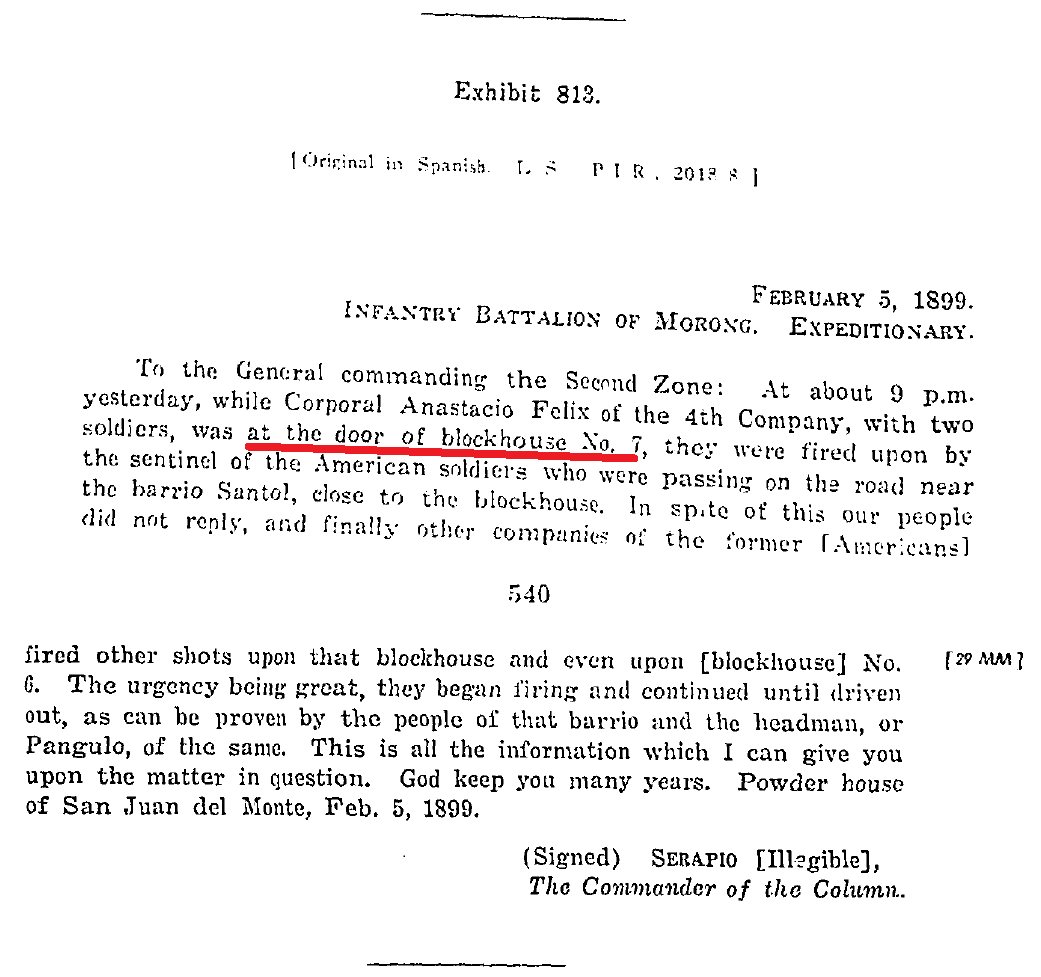
Taylor, Vol. 4
| DOOR = GATEWAY |
In fact, there's a perfect match between Grayson's account and the Filipino Commander's account on this. While Grayson used the word "gateway," the Filipino Commander used the word "door."
Grayson:
"In a moment something rose slowly up, not twenty feet in front of us. It was a Filipino. They were evidently moving dangerously near. "I yelled 'Halt!' and I made it pretty loud, for I was accustomed to challenging the officer of the guard in approved military style. The man moved. I challenged him with another loud 'Halt!' Then he impudently shouted 'Halto!' at me. Well, I thought the best thing to do was to shoot him. He dropped. If I didn't kill him, I guess he died of fright. Then two Filipinos sprang out of the gateway about fifteen feet from us. I called 'Halt!' and Miller fired and dropped one. I saw that another was left. Well, I think I got my second Filipino that time."
Filipino Commander:
"At about 9 p.m. yesterday, while Corporal Anastacio Felix of the 4th Company, with two soldiers, was the at the door of blockhouse No. 7, they were fired upon by the sentinel of the American soldiers who were passing on the road near the barrio Santol, close to the blockhouse."
Both Grayson and the Filipino Commander were obviously referring to the front of this Filipino outpost, a subpost of Blockhouse 7.
| THE PROBABLE SCENARIO |

|
BASED ON THE FOREGOING, THIS STUDY CONCLUDES THAT THE FIRST SHOT OCCURRED AT THE TURN TOWARDS BLOCKHOUSE 7 OR AT THE CORNER OF SOCIEGO-ARGUELLES (NOT AT SOCIEGO-SILENCIO) |
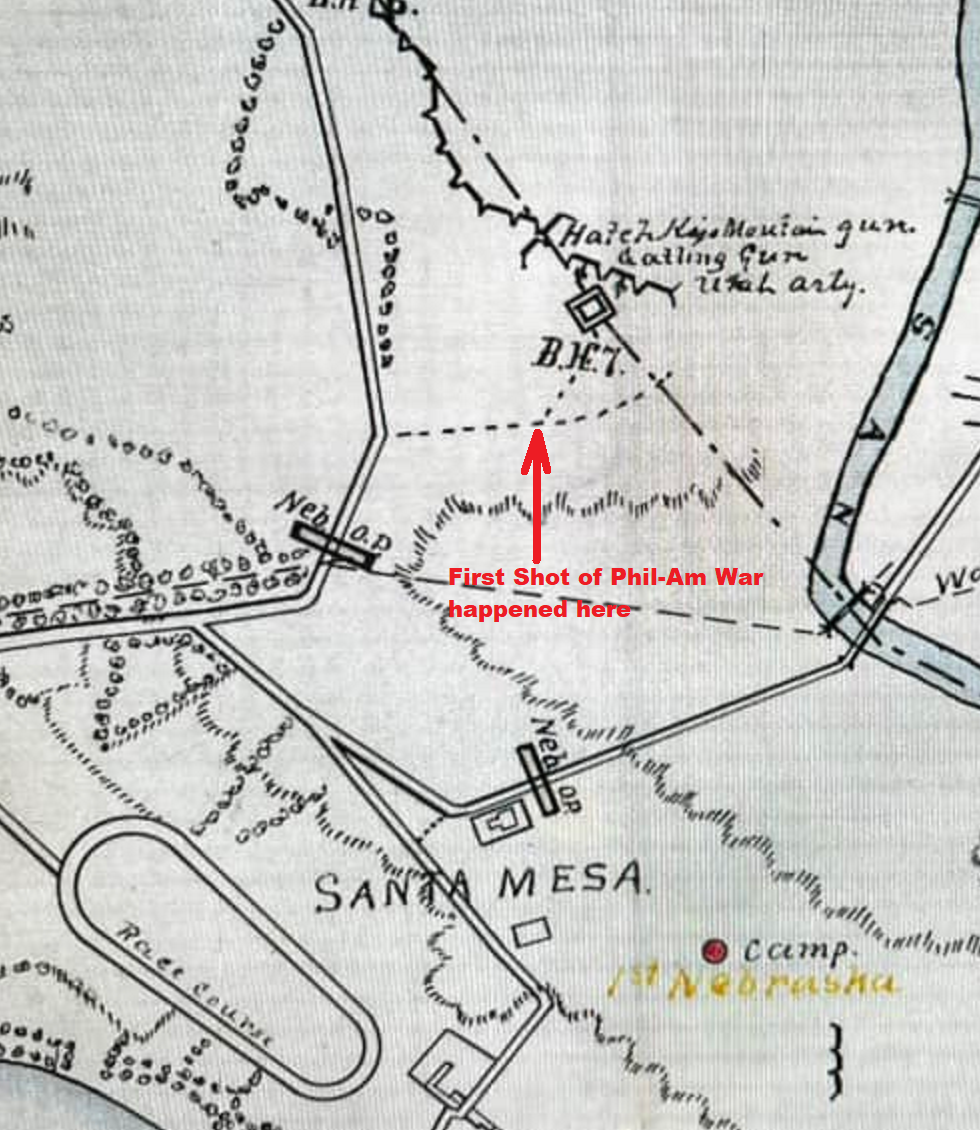

Original image from: Geospatial Analysis of the First Shot of the Philippine-American War
Ariel C. Blanco, Rene R. Escalante, Emmanuel N. Encarnacion
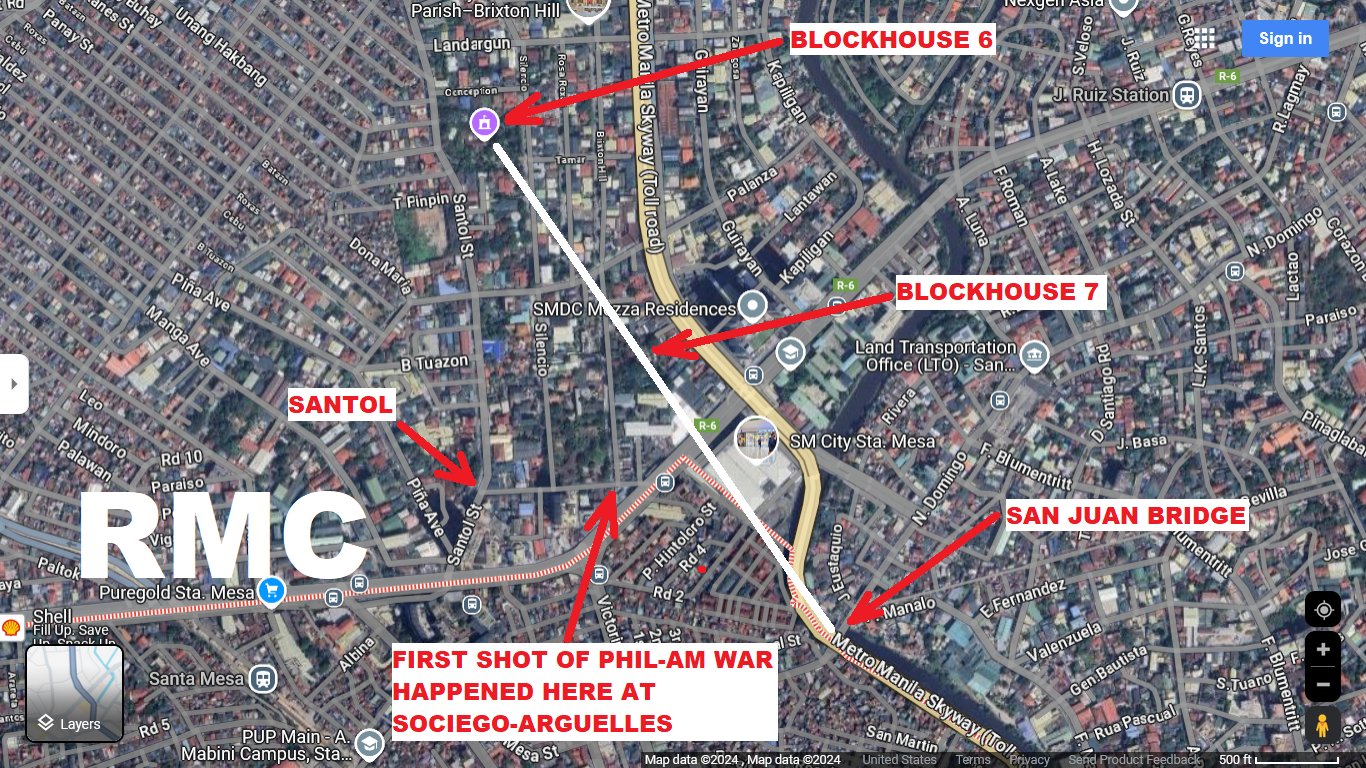
|
THIS CONCLUSION IS CONSISTENT WITH THE GEOSPATIAL ANALYSIS WHICH STATES THAT THE "TURN TO BLOCKHOUSE 7" IS A POSSIBLE SPOT |
The "Geospatial Analysis of the First Shot of the Philippine-American War" states that the "turn to Blockhouse 7" is a possible spot.

Image from: Geospatial Analysis of the First Shot of the Philippine-American War
Ariel C. Blanco, Rene R. Escalante, Emmanuel N. Encarnacion
|
WHILE THEIR EVIDENCE IS THE FENCE THIS STUDY BRINGS UP BLOCKHOUSE 7 IN THE PHOTO AS ADDITIONAL AND OVERWHELMING EVIDENCE |
While their evidence is the fence, this study brings up the presence of Blockhouse 7 in the photo as additional and overwhelming evidence. The outline of Blockhouse 7 here is almost identical to that of the known photo of Blockhouse 7 which was taken from the direction of the trail.
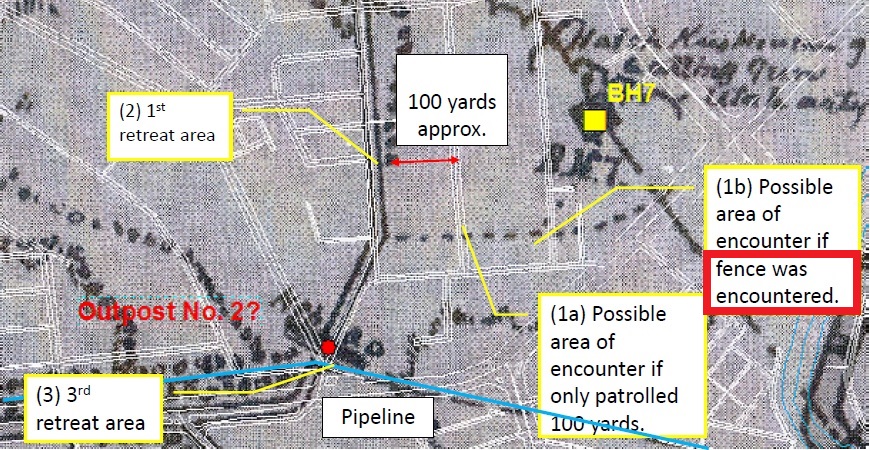
Image from: Geospatial Analysis of the First Shot of the Philippine-American War
Ariel C. Blanco, Rene R. Escalante, Emmanuel N. Encarnacion
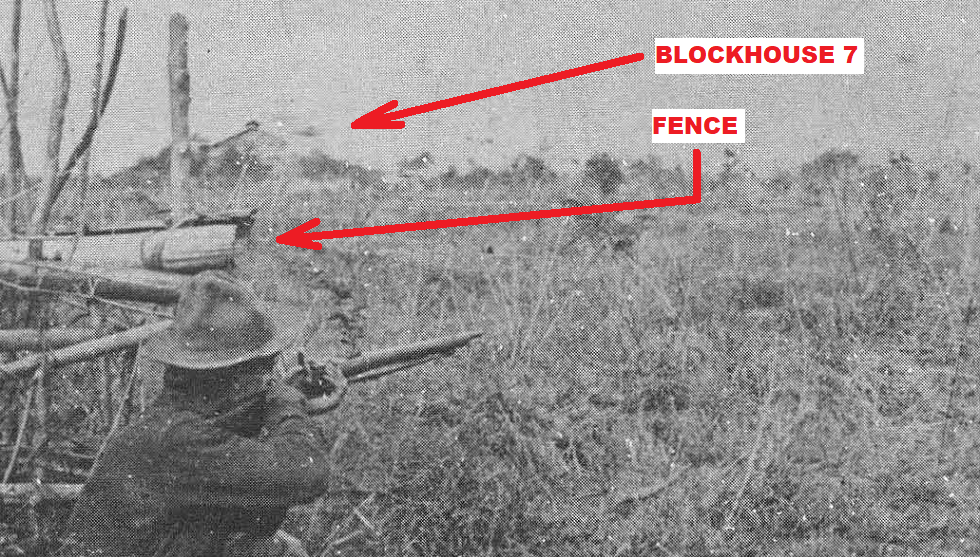
|
ON THE OTHER HAND THE ARGUMENT FOR SOCIEGO-SILENCIO IS DEEPLY FLAWED IF NOT ERRONEOUS |
The only argument for Sociego-Silencio is that it lies one hundred yards from Santol, 100 yards being the farthest that Lieut. Whedon had ordered his men to patrol.
But the Geospatial Analysis and the Legarda Paper erred in injecting their own measurements when they should have adopted Whedon's measurement instead, despite the Legarda Paper's claim to have used "Whedon's calculation of 100 yards."
Since it was Lieut. Whedon who said he ordered his men to patrol 100 yards, it should be Lieut. Whedon's estimate of what a 100 yard distance is that should be considered, not my estimate, not the Geospatial Analysis' estimate, not Dr. Legarda's estimate, not even the actual distance.
And Lt. Whedon never said that from Santol to Sociego-Silencio is 100 yards.
Instead, according to Lieut. Whedon, the distance between Outpost 2 and Santol is 100 yards. On the old military map and current satellite map, that's the same distance between Santol and the "turn towards Blockhouse 7," or the distance between Santol and corner Sociego-Arguelles, which would also be 100 yards per Lieut. Whedon's estimate.
This means that when Lieut. Whedon ordered his men to patrol 100 yards, he meant them to go all the way to the "turn towards Blockhouse 7" or the corner of Sociego-Arguelles, and not just up to Sociego-Silencio.

|
THE GEOSPATIAL ANALYSIS ERRED IN NOT USING LT WHEDON'S ESTIMATE OF 100 YARDS |
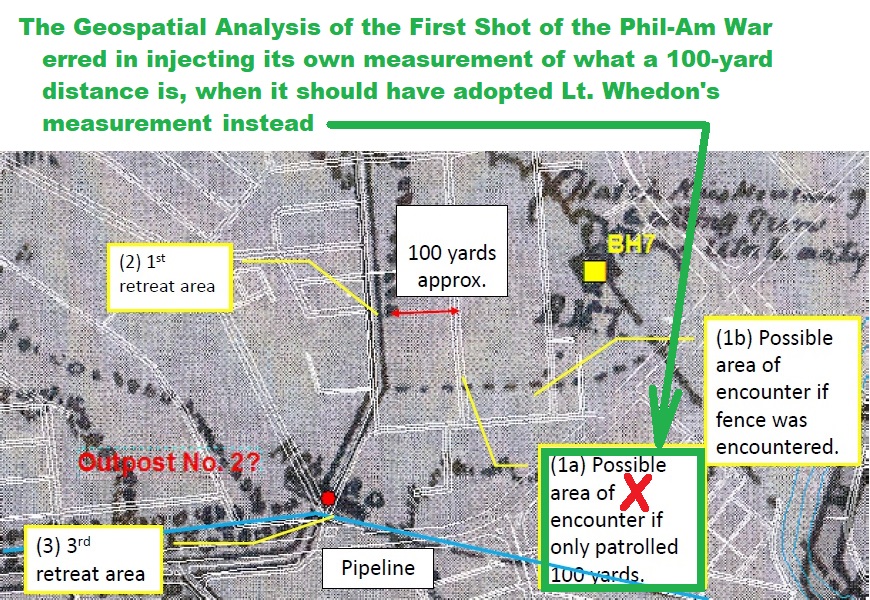
Original image from: Geospatial Analysis of the First Shot of the Philippine-American War
Ariel C. Blanco, Rene R. Escalante, Emmanuel N. Encarnacion
|
THE LEGARDA PAPER, MEANWHILE, USED THE WRONG DISTANCE IN LT. WHEDON'S CALCULATION OF 100 YARDS |
The Legarda Paper failed to use Lt. Whedon's estimate of what a 100 yard is, despite its claim of having used "Whedon's calculation of 100 yards."
Lieut. Whedon never said that from Santol to Sociego-Silencio is 100 yards.
To the contrary, Lt. Whedon said that from Outpost 2 to Santol is 100 yards, and on the map, this is the same distance between Santol and the "turn towards Blockhouse 7," or between Santol and Sociego-Arguelles (which is twice the distance between Santol and Sociego-Silencio.)

The Road to Blockhouse 7, by Benito J. Legarda, Jr. (provided by Eufemio Agbayani III)
| THAT'S THE ONLY ATTEMPT BY THE LEGARDA PAPER TO PUT THE INCIDENT AT AN EXACT SPOT AND IT MISSED THE MARK |
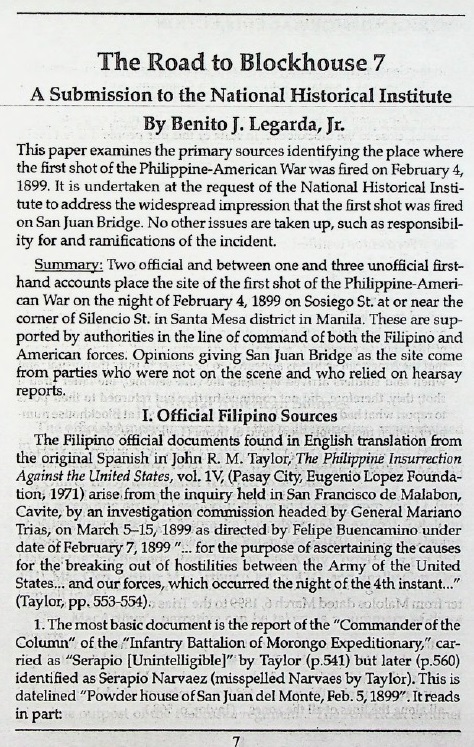
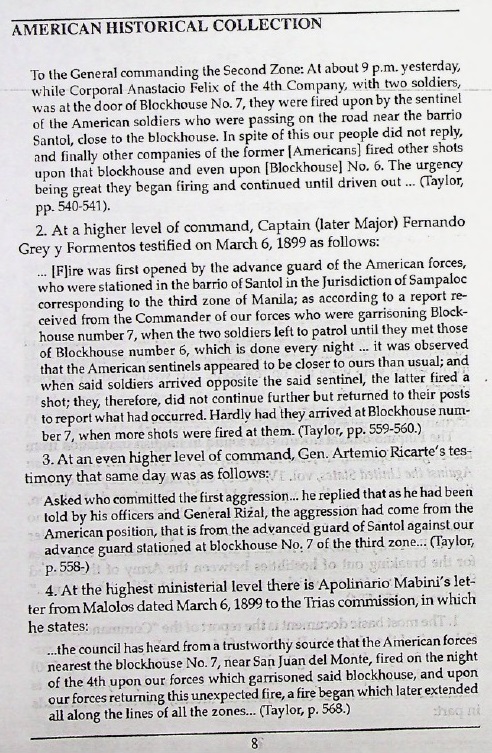
The Road to Blockhouse 7, by Benito J. Legarda, Jr. (provided by Eufemio Agbayani III)
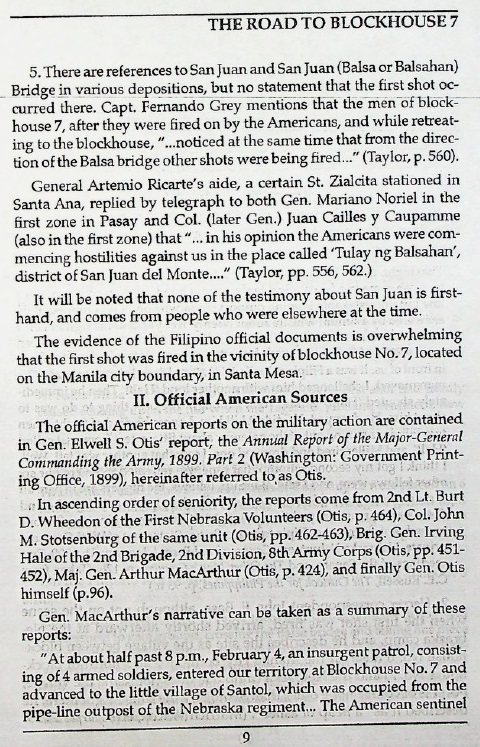
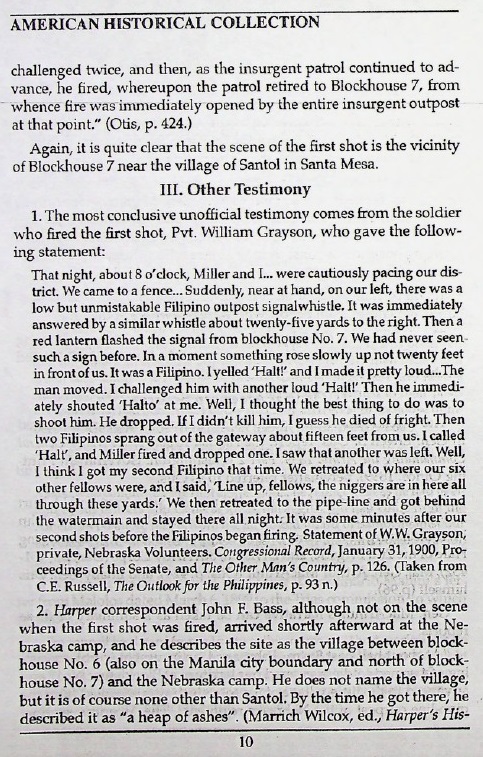
The Road to Blockhouse 7, by Benito J. Legarda, Jr. (provided by Eufemio Agbayani III)
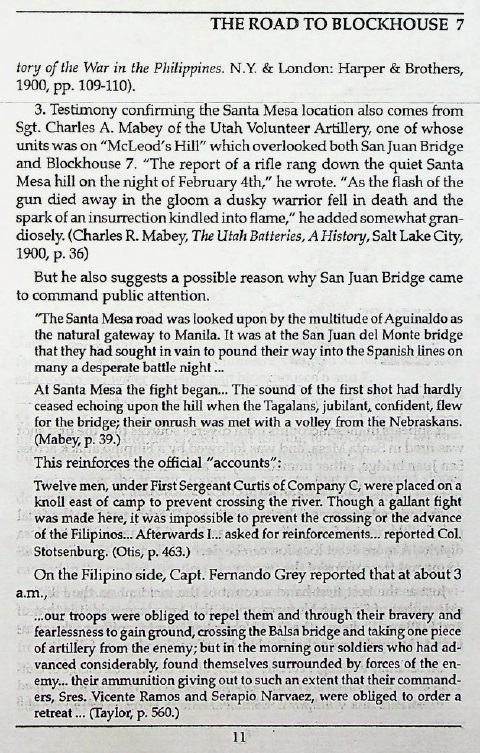

The Road to Blockhouse 7, by Benito J. Legarda, Jr. (provided by Eufemio Agbayani III)
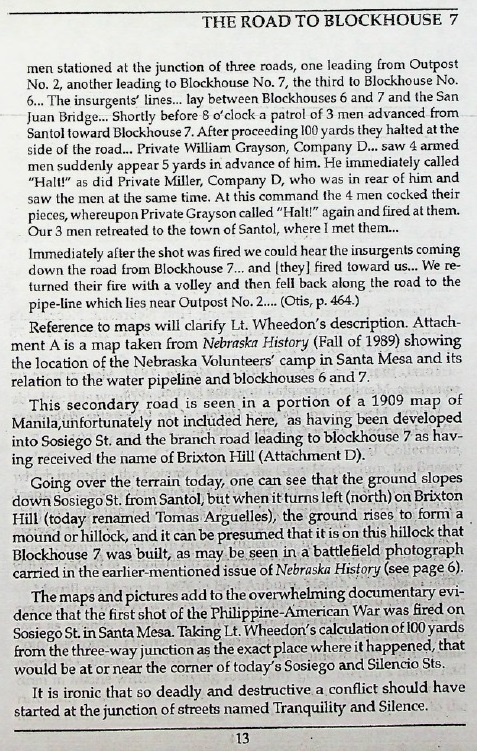
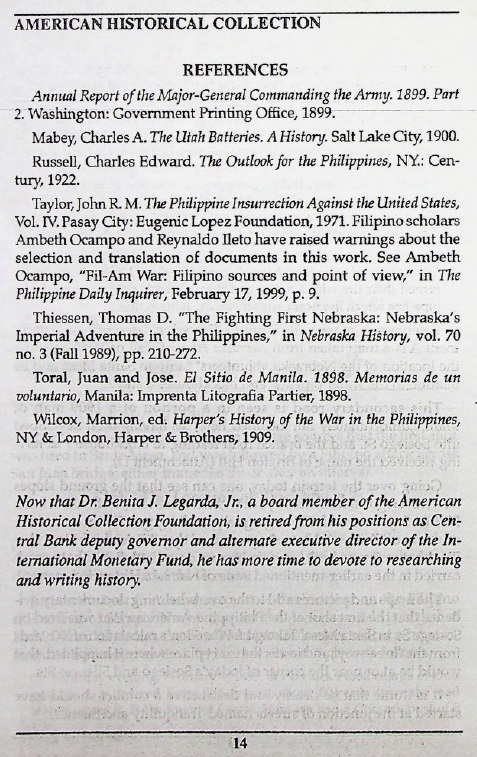
The Road to Blockhouse 7, by Benito J. Legarda, Jr. (provided by Eufemio Agbayani III)
|
PROF. AMBETH R. OCAMPO ADMITS THAT SOCIEGO-SILENCIO IS NOT CONCLUSIVE |
Prof. Ambeth R. Ocampo admits that Sociego-Silencio is not conclusive. In his opinion column in the Inquirer of February 3, 2021, he said "it remains uncertain that the present Silencio corner Sociego is the exact site of the First Shot."
The First Shot: Quiet, silence, and a bridge.
Prof. Ocampo's opinion is significant as it was on his watch as the Chair of the National Historical Institute (NHI) when the "First Shot" marker was transferred from San Juan Bridge to corner Sociego-Silencio.

The First Shot: Quiet, silence, and a bridge; by Prof. Ambeth R. Ocampo; Inquirer, February 3, 2021,
|
THE N.H.C.P. ADMITS THAT SOCIEGO-SILENCIO IS NOT CONCLUSIVE |
In the NHCP article of Eufemio Agbayani III, Historic Sites Development Officer II, entitled "Marking the Philippine-American War" and posted on February 3, 2023, reference was made to the Geospatial Study of the First Shot of Phil-Am War, as follows, which provides that Sociego-Silencio as the location of the first shot of Phil-Am War is not conclusive.
"In 2014, another attempt to verify the location was done by overlapping existing maps from the period and studying them considering contemporary accounts. It affirmed that the first encounter happened along
https://nhcp.gov.ph/articles/marking-the-philippine-american-war/
| THE MARKER AT SOCIEGO-SILENCIO WAS BASED ON THE FAULTY OR ERRONEOUS LEGARDA PAPER |
The main objective of the Legarda Paper was to show that the First Shot did not happen on San Juan Bridge as previously thought.
However, in the next step, which is to identify the probable spot, this is where it failed.
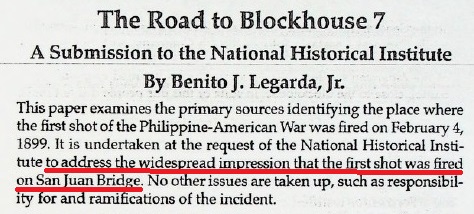
The Road to Blockhouse 7, by Benito J. Legarda, Jr. (provided by Eufemio Agbayani III)
Legarda Paper - Error No. 1
The Legarda Paper failed to use Lieut. Whedon's estimate of what a 100 yard distance is, despite claiming to have used "Whedon's calculation of 100 yards."
According to Lieut. Whedon, the distance between Outpost 2 and Santol is 100 yards. If we look at the old military map and current satellite map, that's the same distance between Santol and the "turn towards Blockhouse 7," or the distance between Santol and Sociego-Arguelles, which would also be 100 yards per Lieut. Whedon's estimate.
Had the Legarda Paper used Lieut. Whedon's estimate, it would identify the corner of Sociego-Arguelles as the location of the first shot, and not Sociego-Silencio.
Col. Stotsenburg also corroborated Lieut. Whedon's distance estimate.
Legarda Paper - Error No. 2
The Legarda Paper failed to recognize the presence of Blockhouse 7 in the background of Grayson's reenactment photo.
This presence of Blockhouse 7 provides the smoking gun as to where exactly Grayson was when he fired the first shot.
By comparing the profile of Blockhouse 7 here with its profile in a known Blockhouse 7 photo, we can triangulate where exactly the first shot happened, and that's at the "turn towards Blockhouse 7" or the corner of Sociego-Arguelles.
Legarda Paper - Error No. 3
The Legarda Paper failed to recognize the significance of the fence in Grayson's reenactment photo.
According to the "Geospatial Analysis of the First Shot of the Philippine-American War," this fence indicates that the incident happened at the "turn towards Blockhouse 7" or the corner of Sociego-Arguelles.

| THE CORRECT LOCATION OF THE MARKER SHOULD BE AT THE CORNER OF SOCIEGO STREET AND TOMAS ARGUELLES STREET |
The corner of Sociego Street and Tomas Arguelles Street should jibe well with the "turn" towards Blockhouse 7.

The Road to Blockhouse 7, by Benito J. Legarda, Jr. (provided by Eufemio Agbayani III)
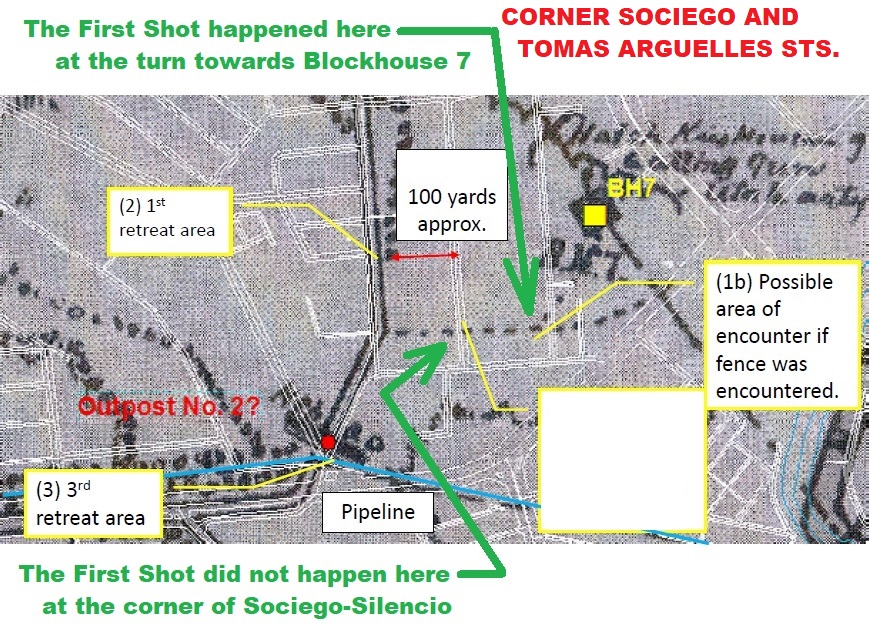
Original image from: Geospatial Analysis of the First Shot of the Philippine-American War
Ariel C. Blanco, Rene R. Escalante, Emmanuel N. Encarnacion

| SCOTT SLATEN CONCURS WITH THESE FINDINGS |
Scott Slaten, a retired U.S. Army officer and the leading American researcher at the Philippine American War facebook group of David Metherel agrees with this paper and its findings.
Scott says:
"I concur with his research and location of the first shot. That is where I have always concluded it was located from the descriptions of Grayson. A good article and well thought out research."
| SUBMITTED TO THE NHCP |
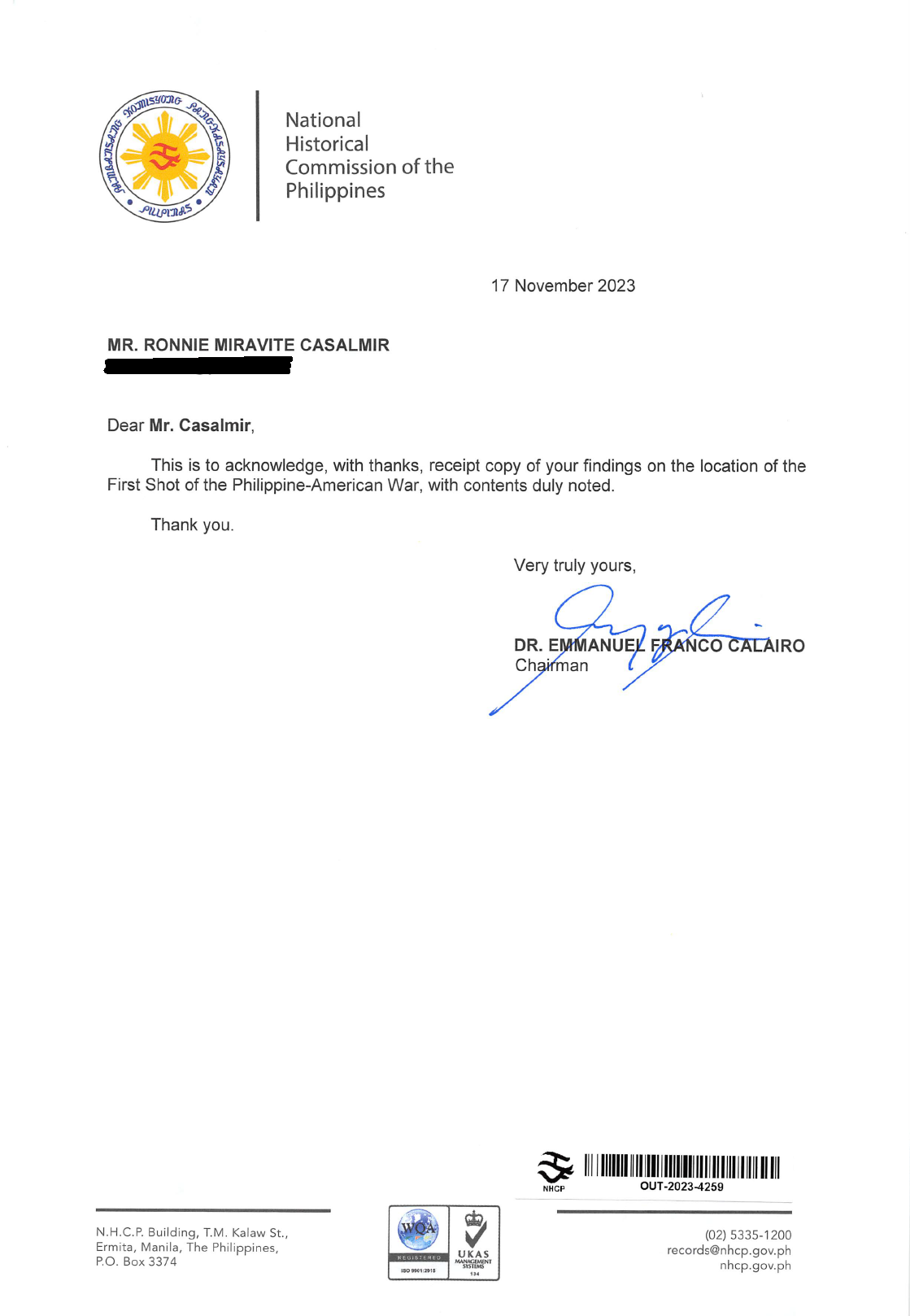
| RESOURCES |
Grayson's Story of the First Shot - Dissection of the official report, and personal letter, of Lieut. Burt D. Whedon, as well as Grayson's statement
Omaha Daily Bee, August 6 1899 - Photo of Grayson's reenactment captioned as "Private Grayson firing the shot that precipitated the war with the Filipinos at Block House on the Hill"
Private William W. Grayson's War in the Philippines, 1899 (PDF DOWNLOAD) - Photo of Grayson's reenactment is on pdf page 3 (page 356 on page), Nebraska State Historical Society
The Fighting First Nebraska: Nebraska's Imperial Adventure in the Philippines (PDF DOWNLOAD) - Photo of Blockhouse No. 7 is on pdf page 32 (page 239 on page), Nebraska State Historical Society
Omaha Daily Bee, August 6 1899 - Statement of Grayson (Grayson's Story of His First Shot)
Omaha Daily Bee, August 30 1899 - Report of Lieut. Burt D. Whedon
Geospatial Analysis of the First Shot of the Philippine-American War - by Ariel C. Blanco, Rene R. Escalante, Emmanuel N. Encarnacion
The First Shot: Quiet, silence, and a bridge - by Ambeth R. Ocampo
